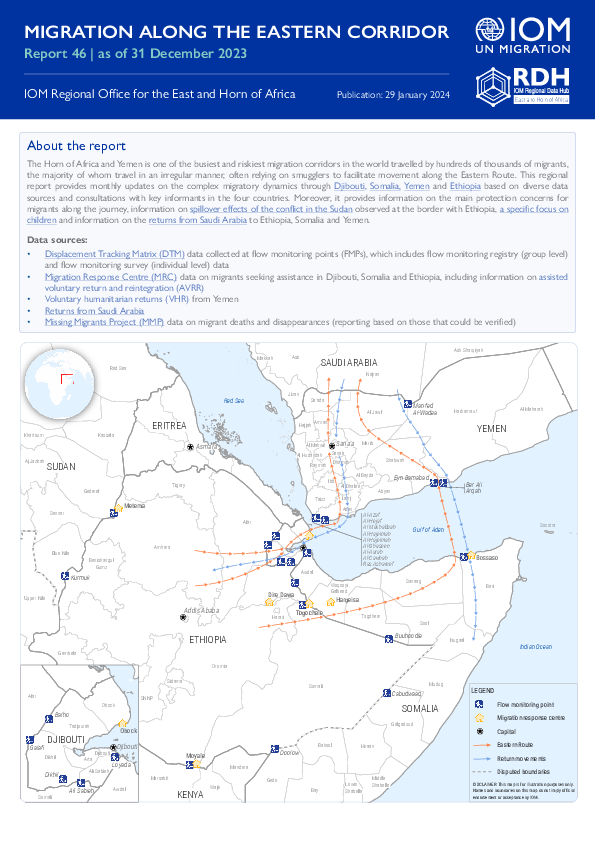-
Countries
-
Data and Analysis
-
Special Focus
-
Crisis Responses
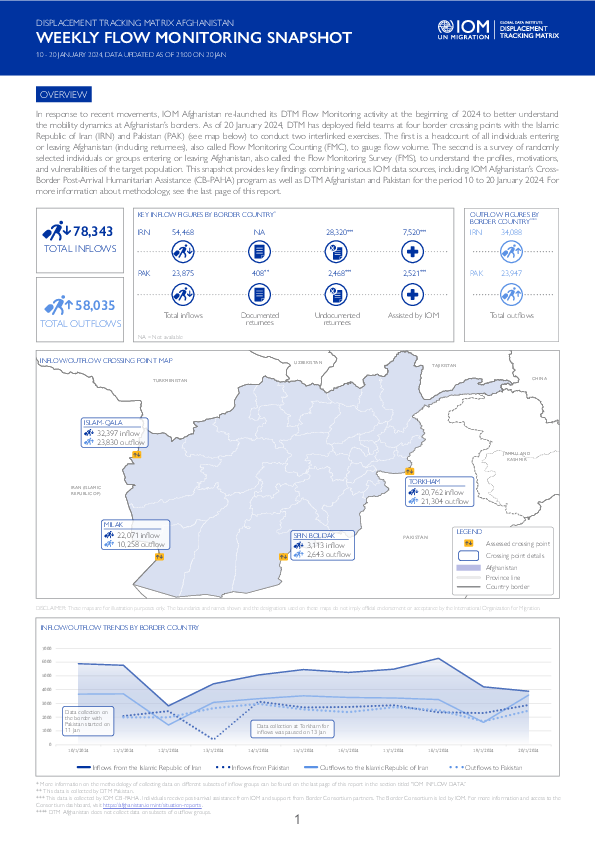
Contact
DTMAfghanistan@iom.int
Language
English
Location
Afghanistan
Period Covered
Jan 10 2024
Jan 20 2024
Activity
- Survey
- Flow Monitoring Survey
- Flow Monitoring
In response to recent movements, IOM Afghanistan re-launched its DTM Flow Monitoring activity at the beginning of 2024 to better understand the mobility dynamics at Afghanistan’s borders. Since 10 January, DTM has deployed field teams at four border crossing points with the Islamic Republic of Iran (IRN) and Pakistan (PAK) (see map below) to conduct two interlinked exercises. The first is a headcount of all individuals entering or leaving Afghanistan (including returnees), also called Flow Monitoring Counting (FMC), to gauge flow volume. The second is a survey of randomly selected individuals or groups entering or leaving Afghanistan, also called the Flow Monitoring Survey (FMS), to understand the profiles, motivations, and vulnerabilities of the target population. This snapshot provides key findings combining various IOM data sources, including IOM Afghanistan’s Cross-Border Post-Arrival Humanitarian Assistance (CB-PAHA) program as well as DTM Afghanistan and Pakistan for the period 10 to 20 January 2024. An interactive dashboard on all data collected since the inception of the Flow Monitoring activity on 10 January can be found HERE.

Contact
mtmuzbekistan@iom.int
Language
English
Location
Uzbekistan
Period Covered
Apr 01 2024
Sep 30 2024
Activity
- Flow Monitoring Survey
- Migrants presence
- Mobility Tracking
Mazkur hisobot 2023-yilning aprel-sentabr oylari uchun ichki va tashqi ko‘chishlar hamda migrantlar guruhlari bo‘yicha milliy va xalqaro maʼlumotlar to‘plamlaridan olingan ochiq maʼlumotlarga asoslanib, O‘zbekistondagi migratsiyaga oid so‘nggi maʼlumotlar va jarayonlarni qamrab oladi. Hisobot mamlakatdagi ichki va xalqaro migratsiyaga ta’sir ko‘rsatuvchi so‘nggi yirik global va mintaqaviy voqealarni, xususan, Rossiyaning Ukrainaga bosqini davom etishi hamda buning natijasida mintaqadagi an’anaviy insonlar mobillligi shakllarining o‘zgarishi, shuningdek, urbanizatsiya jarayoni, iqlim o‘zgarishi va o‘sib borayotgan suv tanqisligi kabi masalalar insonlar mobilligini ta’minlovchi omillar sifatida aks ettiradi.
The Horn of Africa and Yemen is one of the busiest and riskiest migration corridors in the world travelled by hundreds of thousands of migrants, the majority of whom travel in an irregular manner, often relying on smugglers to facilitate movement along the Eastern Route. This regional report provides monthly updates on the complex migratory dynamics through Djibouti, Somalia, Yemen and Ethiopia based on diverse data sources and consultations with key informants in the four countries. Moreover, it provides information on the main protection concerns for migrants along the journey, information on the spillover effects of the conflict in the Sudan observed at the border with Ethiopia, a specific focus on children and information on the returns from Saudi Arabia to Ethiopia, Somalia and Yemen.
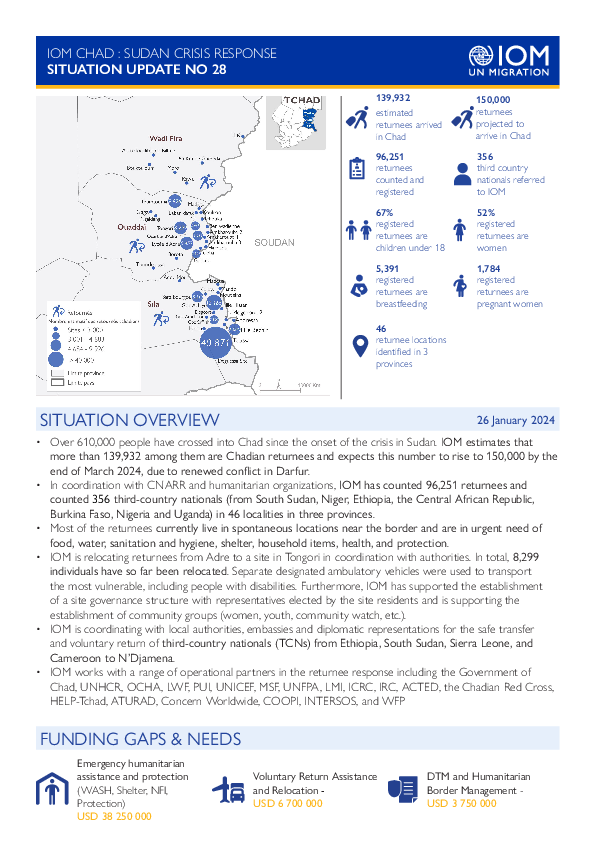
Contact
DTM Chad, dtmtchad@iom.int
Language
English
Location
Chad
Period Covered
Jan 26 2024
Jan 26 2024
Activity
- Mobility Tracking
- Event Tracking
Over 610,000 people have crossed into Chad since the onset of the crisis in Sudan. IOM estimates that more than 139,932 among them are Chadian returnees and expects this number to rise to 150,000 by the end of March 2024, due to renewed conflict in Darfur.
• In coordination with CNARR and humanitarian organizations, IOM has counted 96,251 returnees and counted 356 third-country nationals (from South Sudan, Niger, Ethiopia, the Central African Republic, Burkina Faso, Nigeria and Uganda) in 46 localities in three provinces.
• Most of the returnees currently live in spontaneous locations near the border and are in urgent need of food, water, sanitation and hygiene, shelter, household items, health, and protection.
• IOM is relocating returnees from Adre to a site in Tongori in coordination with authorities. In total, 8,299 individuals have so far been relocated. Separate designated ambulatory vehicles were used to transport the most vulnerable, including people with disabilities. Furthermore, IOM has supported the establishment of a site governance structure with representatives elected by the site residents and is supporting the establishment of community groups (women, youth, community watch, etc.).
• IOM is coordinating with local authorities, embassies and diplomatic representations for the safe transfer and voluntary return of third-country nationals (TCNs) from Ethiopia, South Sudan, Sierra Leone, and Cameroon to N’Djamena.
• IOM works with a range of operational partners in the returnee response including the Government of Chad, UNHCR, OCHA, LWF, PUI, UNICEF, MSF, UNFPA, LMI, ICRC, IRC, ACTED, the Chadian Red Cross, HELP-Tchad, ATURAD, Concern Worldwide, COOPI, INTERSOS, and WFP

Contact
DTMUkraine@iom.int
Language
English
Location
Ukraine
Period Covered
Jan 02 2024
Jan 11 2024
Activity
- Mobility Tracking
This report serves to identify the heating systems employed in Ukrainian households, presents the estimated prices of solid fuel items across different oblasts, and examines the methods and frequency of solid fuel collection by the Ukrainian population. The report investigates the current and future demand, supply, and prices of essential solid fuel products. The overarching objective is to support ongoing humanitarian winterization operations.
Between 2 and 11 January 2024, the Data and Analytics (D&A) team surveyed 287 markets in 23 oblasts and Kyiv City in Ukraine, conducting face-to-face and remote interviews with both local vendors and community focal points (CFPs). In each oblast, data was collected in at least two locations, one urban and one rural and/or near frontline locations, where applicable. In each location, a minimum of two vendors and two CFPs (non-vendors) were surveyed. The CFPs were chosen based on their familiarity with the subject matter and knowledge of winterization preparation at the community level.

Contact
iombuenosaires@iom.int
Language
Spanish
Location
Argentina
Period Covered
Aug 01 2023
Sep 30 2023
Activity
- Survey
- Flow Monitoring Survey
Actualmente, se estima que aproximadamente 7, 7 millones de personas de nacionalidad venezolana se encuentran fuera de la República Bolivariana de Venezuela1 , de las cuales 6.5 millones residen en países de América Latina y el Caribe. En la República Argentina, residen más de 200.000 personas venezolanas , siendo este flujo poblacional uno de los más dinámicos en años recientes en un país históricamente receptor de inmigración. La magnitud de este movimiento de población resulta inédita en la historia reciente de América Latina y el Caribe e involucra tanto a refugiados como migrantes de aquel país.
La experiencia demuestra que los movimientos poblacionales a gran escala persisten y se pueden complejizar en ausencia de soluciones políticas y solidaridad internacional continua. Dada la magnitud de la salida de personas venezolanas, solo un enfoque integral y coordinado a nivel regional entre los gobiernos, con el apoyo de la comunidad internacional, permitirá a la región hacer frente a la magnitud de este influjo.
Con este objetivo en mente, el Plan Regional de Respuesta para Refugiados y Migrantes Venezolanos (RMRP, por sus siglas en inglés) se ha desarrollado para apoyar y complementar la labor de las autoridades nacionales de América Latina y el Caribe, respondiendo a las necesidades de la población de manera integral y exhaustiva y en el marco de los mecanismos regionales de respuesta y coordinación.
Desde 2018 OIM Argentina ha implementado la Matriz de Seguimiento del Desplazamiento (DTM, por sus siglas en inglés) en su modalidad de Encuesta de Monitoreo de Flujos (en diversos puntos de ingreso al territorio nacional y de estancia). La DTM es un sistema para monitorear movimientos de población y cuenta con una variedad de herramientas de medición.
Cada una de ellas puede ser adaptada para dar seguimiento de forma sistemática y regular al desplazamiento de personas en diversos contextos. Su objetivo principal consiste en conocer el perfil y mejorar la comprensión de las necesidades de la población que se moviliza en diferentes situaciones.
Desde 2018, la implementación de la DTM en la República Argentina ha tenido como objetivos: caracterizar a la población venezolana que arriba o que reside en el país, para conocer sus aspectos sociodemográficos, las rutas recorridas, su situación migratoria, laboral, sus posibilidades de acceso a la salud, a los alimentos, a la vivienda y a la información. También se indaga acerca de las necesidades concretas de asistencia y sobre los procesos de reunificación familiar que las personas encuestadas consideran experimentarán en el corto o mediano plazo. La DTM ronda 15 se realizó durante los meses de agosto y septiembre de 2023. Las encuestas se aplicaron en la Ciudad Autónoma de Buenos Aires, Ciudad de Córdoba (Córdoba) y Rosario (Santa Fe).
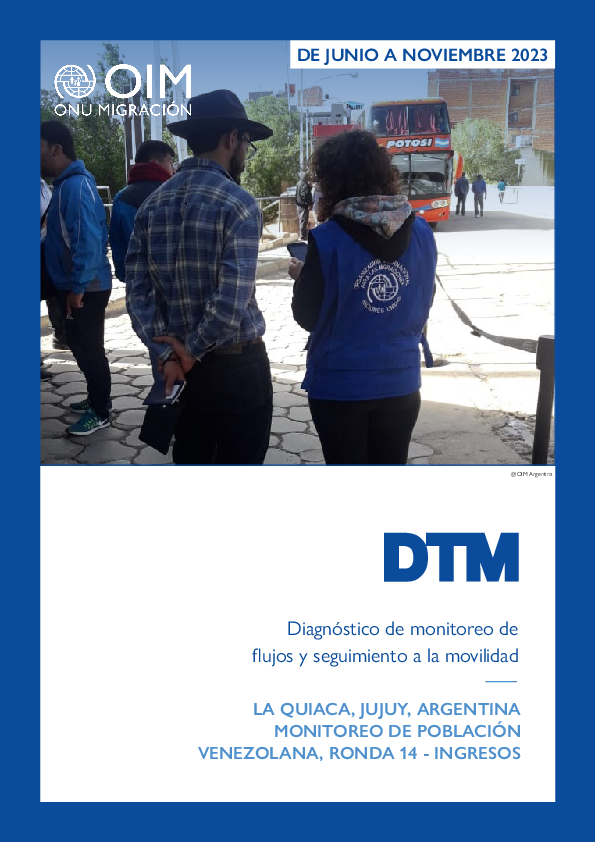
Contact
iombuenosaires@iom.int
Language
Spanish
Location
Argentina
Period Covered
Jun 01 2023
Nov 30 2023
Activity
- Survey
- Flow Monitoring Survey
En diciembre de 2023 se estima que aproximadamente 7,7 millones de personas de nacionalidad venezolana residen fuera de su país, de las cuales 6,5 millones lo hacen en países de América Latina y el Caribe1 . En la República Argentina, el Censo Nacional de Población, Hogares y Viviendas da cuenta de que residen 161.495 personas venezolanas, siendo este flujo poblacional uno de los más dinámicos en años recientes en un país históricamente receptor de inmigración (INDEC, 2024).
Los flujos de personas refugiadas y migrantes venezolanas revisten especial interés, dado que presentan necesidades específicas que los distinguen de otros grupos de inmigrantes de la región. Se trata de movimientos a gran escala, sostenidos en el tiempo, que requieren de soluciones políticas y solidaridad internacional. Con el fin de garantizar un enfoque integral y coordinado a nivel regional entre los gobiernos, actores de sociedad civil y la comunidad internacional, surge la Plataforma Regional de Coordinación Interagencial que fue creada en conformidad con la solicitud del Secretario General de las Naciones Unidas al ACNUR y la OIM el 12 de abril de 2018, para dirigir y coordinar la respuesta a los/as refugiados/as y migrantes de la República Bolivariana de Venezuela (en adelante Venezuela).
En este marco se crea la Plataforma Nacional de Respuesta para Refugiados y Migrantes de Venezuela en la República Argentina que actualmente forma parte del capítulo subregional Cono Sur incluido en la Plataforma Regional. A su vez, La Organización Internacional para las Migraciones (OIM) Argentina es colidera el Sector de Manejo de Información de la Plataforma Nacional, que se encarga de aunar esfuerzos para brindar asistencia en materia de manejo de información al equipo de coordinación.
La Matriz de Seguimiento del Desplazamiento (DTM por sus siglas en inglés), en tanto herramienta utilizada por OIM en situaciones de emergencia, reviste un instrumento fundamental a la hora de proveer información sobre el perfil y las necesidades de la población venezolana. Desde 2018 se han implementado 14 rondas de Monitoreo de Flujo y de Encuesta en lugares de residencia, con la finalidad de mejorar las acciones destinadas a este grupo. En el informe a continuación se presentan los resultados de la Ronda 14, que tuvo entre sus objetivos caracterizar a la población venezolana que ingresa al país por vías terrestres y brindar información sobre rutas migratorias, características de su viaje, necesidades de asistencia, protección y reunificación familiar.
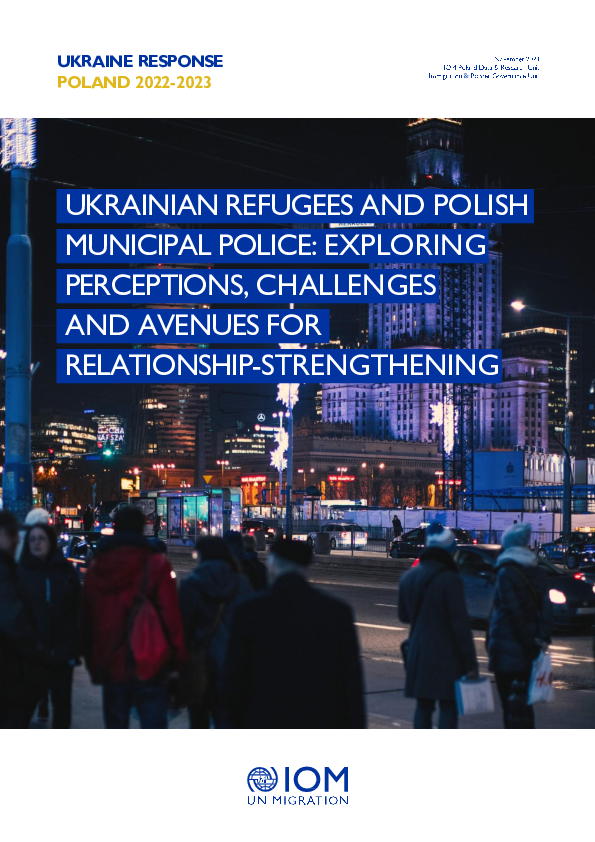
Contact
DTM Poland: IOMDTMPoland@iom.int
Language
English
Location
Poland
Period Covered
Oct 09 2023
Nov 10 2023
Activity
- Survey
- Community Perception
As of December 2023, more than 6 million refugees from Ukraine have fled to other countries because of the war which began in February 2022. More than 950,000 of these refugees are living in neighboring Poland. With this sudden influx of refugees, Polish society and institutions responded quickly to support their new Ukrainian arrivals through initiating social protection programs, collective site housing, and providing immediate assistance to those entering through the borders with Ukraine. Polish law enforcement – including the Polish border guard, police, and municipal police – played a key role in supporting Ukrainian refugees.
As the conflict continues and as many refugees have now lived in Poland for over a year, there is a need for research and programming on the various aspects enabling durable solutions – one of these being the ways in which Ukrainian refugees interact with and perceive Polish law enforcement. Even before the onset of the war there was a sizable Ukrainian population in Poland, meaning that Polish law enforcement officers’ interactions with and perceptions of Ukrainians may include both refugees who arrived after and migrants who arrived before February of 2022. From the law enforcement perspective, it can be challenging to distinguish whether an individual is a refugee, so for this reason our research also touches on the perceptions and experiences of Ukrainian migrants who resided in Poland before the war began (e.g. those who lived in Poland prior to February of 2022). This study aims to provide insights into the interactions, perceptions, and potential areas for improvement in the relationship between Ukrainians in Poland (with a focus on the refugee population) and Polish law enforcement (specifically focusing on Polish municipal police). The report covers IOM’s main research findings as well as recommendations both for Polish law enforcement’s engagement with Ukrainian communities and for future humanitarian programming.

Contact
DTM Nigeria, iomnigeriadtm@iom.int
Language
English
Location
Nigeria
Period Covered
Jan 08 2024
Jan 14 2024
Activity
- Mobility Tracking
- Event Tracking
Between 08 and 14 January 2024, a total of 6,114 new arrivals were recorded at locations in Adamawa and Borno states. The new arrivals were recorded at locations in Askira/Uba, Bama, Biu, Dikwa, Gwoza, Hawul, Kaga, Kwaya/Kusar, Mobbar, Monguno and Ngala Local Government Areas (LGAs) of the most conflict-affected Borno State and in Fufore, Girei, Gombi, Guyuk, Hong, Madagali, Maiha, Michika, Mubi North, Mubi South, Numan, Song, Yola North and Yola South LGAs of Adamawa State.
ETT assessments identified the following movement triggers: Attacks (4,286 individuals or 70%), poor living conditions (997 individuals or 16%), family re-unification (215 individuals or 4%), military operations (195 individuals or 3%), fear of attack (178 individuals or 3%), access to humanitarian support (125 individuals or 2%), improved security (74 individuals or 1%) and seasonal farming (44 individuals or 1%).

Contact
DTM Nigeria, iomnigeriadtm@iom.int
Language
English
Location
Nigeria
Period Covered
Jan 01 2024
Jan 07 2024
Activity
- Mobility Tracking
- Event Tracking
On 1 January 2024, a non-state armed group (NSAG) reportedly attacked Gatawarwa Town in the Gatamarwa ward of Chibok LGA in Borno State. The attack affected 114 individuals. As a result of the attack, 12 fatalities and 16 injuries were reported.
On 7 January 2024, NSAG reportedly attacked Kwapre in Garaha ward of Hong LGA of Adamawa State. The attack affected 1,952 individuals and displaced 530 individuals to the communities of Thabu and Cross River in Thilbang ward and 1,322 individuals to the communities of Kwabaktina, Kukurpu and Waja in Hong ward of Hong LGA. As a result of the attack, three fatalities and 30 injuries were recorded.
